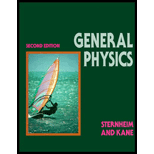
(a)
The energy difference between
(a)
Answer to Problem 37E
The energy difference is
Explanation of Solution
Write the expression for the energy of the
Here,
Conclusion:
Substitute
Substitute
Evaluate the difference between
Thus, the energy difference is
(b)
The energy difference between
(b)
Answer to Problem 37E
The energy difference is
Explanation of Solution
Write the expression for the energy of the
Here,
Conclusion:
Substitute
Substitute
Evaluate the difference between
Thus, the energy difference is
Want to see more full solutions like this?
Chapter 28 Solutions
General Physics, 2nd Edition
- Assume that a proton in a nucleus can be treated as if it were confined to a one-dimensional of width 10.0 fm. (a) What are the energies of the proton when it is in the states corresponding to n=1,n=2, and n=3? (b) What are the energies of the photons emitted when the proton makes the transitions from the first and second excited states to the ground state?arrow_forwardIf the energy of the first excited state of the electron in the box is 25.0 eV, what is the width of the box?arrow_forwardWhat is the maximum kinetic energy of an electron such that a collision between the electron and a stationary hydrogen atom in its ground state is definitely elastic?arrow_forward
- Discuss why the allowed energies of the hydrogen atom are negative.arrow_forwardThe work function for potassium is 2.26 eV. What is the cutoff frequency when this metal is used as photoelectrode? What is the stopping potential when for the emitted electrons when this photo electrode is exposed to radiation of frequency 1200 THz?arrow_forwardDo the Balmer series and the Lyman series overlap? Why? Why not? (Hint: calculate the shortest Balmer line and the longest Lyman line.)arrow_forward
 University Physics Volume 3PhysicsISBN:9781938168185Author:William Moebs, Jeff SannyPublisher:OpenStax
University Physics Volume 3PhysicsISBN:9781938168185Author:William Moebs, Jeff SannyPublisher:OpenStax Modern PhysicsPhysicsISBN:9781111794378Author:Raymond A. Serway, Clement J. Moses, Curt A. MoyerPublisher:Cengage Learning
Modern PhysicsPhysicsISBN:9781111794378Author:Raymond A. Serway, Clement J. Moses, Curt A. MoyerPublisher:Cengage Learning Principles of Physics: A Calculus-Based TextPhysicsISBN:9781133104261Author:Raymond A. Serway, John W. JewettPublisher:Cengage Learning
Principles of Physics: A Calculus-Based TextPhysicsISBN:9781133104261Author:Raymond A. Serway, John W. JewettPublisher:Cengage Learning Classical Dynamics of Particles and SystemsPhysicsISBN:9780534408961Author:Stephen T. Thornton, Jerry B. MarionPublisher:Cengage Learning
Classical Dynamics of Particles and SystemsPhysicsISBN:9780534408961Author:Stephen T. Thornton, Jerry B. MarionPublisher:Cengage Learning Physics for Scientists and Engineers with Modern ...PhysicsISBN:9781337553292Author:Raymond A. Serway, John W. JewettPublisher:Cengage Learning
Physics for Scientists and Engineers with Modern ...PhysicsISBN:9781337553292Author:Raymond A. Serway, John W. JewettPublisher:Cengage Learning




